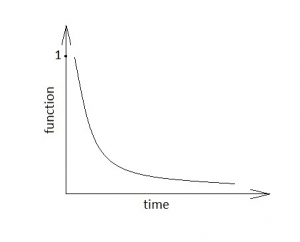This set of Instrumentation Transducers Multiple Choice Questions & Answers (MCQs) focuses on “Standard Test Signals”.
1. Which of the following represents Laplace transform of ramp signal?
a) 1⁄S3
b) 1⁄S2
c) 1⁄S
d) 1
View Answer
Explanation: Ramp function is given as r (t) = t for all t >0. Its Laplace transform gives 1⁄S2.
Laplace transform can be found by:
∫0∞r(t)e-stdt.
2. What does this function represents?

a) u (t)
b) u (t-2)
c) u (t+2)
d) u (-t)
View Answer
Explanation: Given diagram represents a step function, which is shifted to right by two units and can write as u(t-2).
3. Laplace transform function f (t) is F(S), then how will you represent Laplace transform for differential of f (t)?
a) S⁄F(S)
b) F(S)
c) S.F(S)
d) F’(S)
View Answer
Explanation: This is obtained by time differential property of Laplace transform.
4. How will you obtain a given function from unit step signals?
f (t) = 1 for -1≤t≤1 0 otherwise
a) u (t) – u (t+2)
b) u (t+1) – u (t-1)
c) u (t+1) + u(t-1)
d) 2.u (t)
View Answer
Explanation: Given expression cancels common region in two functions, and the remaining will be function of our interest. u(t+1) is step signal with one unit left shifted, and u(t-1) is step signal with one unit right shifted.
5. How will you represent given function?

a) u (t)
b) eat.u(t)
c) e-at.u(t)
d) eat.r(t)
View Answer
Explanation: Given function is a decreasing exponential with initial amplitude one, where u(t) represents step function. u(t) gives initial amplitude and negative power of exponential gives a negative slop to function.
6. Which of the following function is represented using a given condition?
f (t) = 1 for t=0 0 otherwise
a) Step function
b) Sine function
c) Ramp function
d) Impulse function
View Answer
Explanation: Impulse signal has a value only at t=0 and has zero value otherwise. Unit impulse function will have amplitude one at time t=0.
7. What is the result of the expression f(t)= u (t+2) – u (t-3)?
a) f (t) = 1 for -2 ≤ t ≤ 3
b) f (t) = 1 for 2 ≤ t ≤ 3
c) f (t) = 1 for -2 ≤ t ≤ -1
d) f (t) = 1 for -2 ≤ t ≤ 0
View Answer
Explanation: u (t) is step function, and subtracting two shifted step functions will cancel their common region and produces new function. u(t+2) is a step signal with two units shifted left side and u(t-3) is a step signal with three units shifted right side.
8. Transfer function of a system is given by 1/S. If system has a step input, what will be the output in time domain?(Function exist only for positive time value)
a) Step signal
b) Impulse signal
c) Sinusoidal signal
d) Ramp signal
View Answer
Explanation: Transfer function is ratio of Output to Input and hence Output can be obtained as a product of transfer function and input, which gives 1/S2. For a positive sided signal using inverse Laplace transform, output is obtained as ramp signal.
9. Function f (t) has Laplace transform F(S). How will you represent Laplace transform of integral of f(t)?
a) S.F(S)
b) F(S)
c) F(S2)
d) F(S)⁄S
View Answer
Explanation: This is obtained by integration property of Laplace transform.
10. Which of the following represents Laplace transform of sinh(at)?
a) a⁄(S2+a2)
b) a⁄(S2-a2)
c) S⁄(S2+a2)
d) S⁄(S2-a2)
View Answer
Explanation: Given function represents hyperbolic sine function. Hyperbolic sine function can be represented as sinhx= (ex-e-x)⁄2. Applying Laplace transform equation to this expression, we obtain Laplace transform of hyperbolic sine function.
Sanfoundry Global Education & Learning Series – Instrumentation Transducers.
To practice all areas of Instrumentation Transducers, here is complete set of 1000+ Multiple Choice Questions and Answers.
If you find a mistake in question / option / answer, kindly take a screenshot and email to [email protected]
- Practice Instrumentation Engineering MCQs
- Check Instrumentation Transducers Books
- Check Instrumentation Engineering Books
- Apply for Instrumentation Engineering Internship
